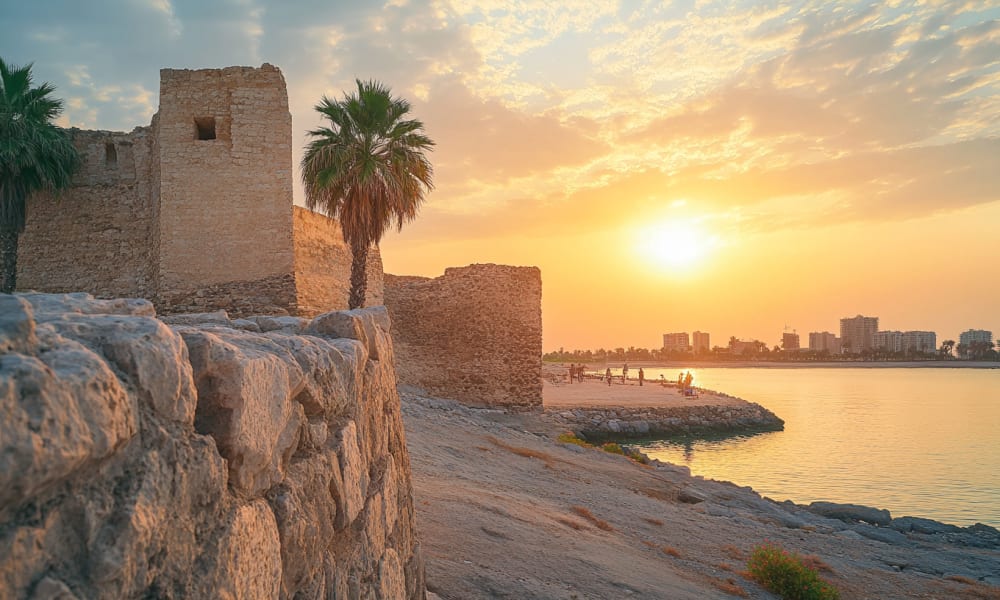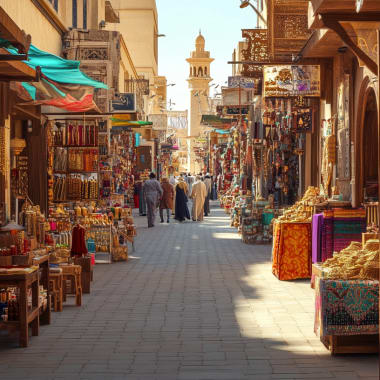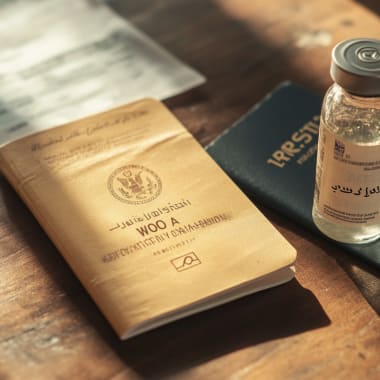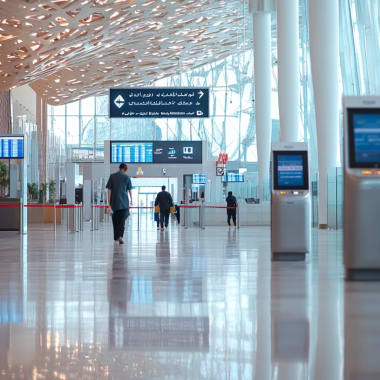
Cultural Highlights in Bahrain
From ancient fortresses to vibrant traditions – Bahrain's cultural treasures tell stories that captivate the soul.
From ancient fortresses to vibrant traditions – Bahrain's cultural treasures tell stories that captivate the soul.
Bahrain may be a small island, but its history is anything but small. Nestled between desert sands and the Arabian Gulf, its cultural heritage is deeply rooted in the Arab world while remaining open to modern influences. To truly understand the essence of this kingdom, one must look beyond the museums and mosques, finding it in the winding streets, spiritual sites, and the warm hospitality of its people.
In this article, we’ll introduce six cultural highlights that make Bahrain an unforgettable destination for travelers – authentic, impactful, and rich in history.
Bahrain Fort (Qal'at al-Bahrain)
An archaeological gem by the sea – witness to 4,500 years of history and cultural exchange.
Why this highlight is so significant for Bahrain
Qal'at al-Bahrain, also known as Bahrain Fort, is one of the most important archaeological sites in the country, and was declared a UNESCO World Heritage site in 2005. This impressive ruin by the sea spans over 4,500 years of history and highlights how various civilizations shaped the cultural heritage of the region.
Once the capital of the legendary Dilmun civilization, Bahrain Fort stands as a testament to one of the oldest trading centers in the Middle East. Dilmun is described in ancient texts as the "Land of Immortality" – a reflection of its early spiritual and economic importance. Due to its strategic location along a natural channel, the fort became a vital hub for trade over the millennia, connecting Mesopotamia, the Indus Valley, China, and the Mediterranean.
Excavations reveal continuous settlement from the 3rd millennium BC to the 16th century AD, providing fascinating insights into urban development, religion, and commerce. Key discoveries include residential houses, workshops, religious structures, and the well-preserved Portuguese fortress atop the hill that gave the site its name. Artifacts such as copper items, Dilmun seals, and Sumerian clay tablets demonstrate the far-reaching cultural exchanges and the significance of Qal'at al-Bahrain as a melting pot of civilizations.
What to expect during your visit
A stroll through Bahrain Fort is like stepping back in time – offering a sensory experience for history buffs and nature lovers alike. Visitors can explore the ruins on their own or join a guided tour, wandering through ancient residential quarters and immersing themselves in the lives of past civilizations.
The 16th-century Portuguese fort is an imposing structure with massive walls and expansive towers. The on-site museum showcases over 500 artifacts – including jewelry, tools, and ceramics – enhanced by interactive displays and multimedia panels that bring the historical context to life.
One of the most atmospheric times to visit is during sunset, when the golden light casts a warm glow over the ancient walls and offers a breathtaking view of the palm trees, the sea, and the modern skyline of Manama. Whether you’re a family, a history enthusiast, or a photographer, you’ll find plenty of inspiring moments here. Occasionally, cultural events and educational programs take place, adding even more variety to your visit.
What you need to know for your trip
Bahrain Fort is open daily from 8:00 AM to 8:00 PM. Access to the site is free, though there is a small fee to visit the museum. The fort is located on Bahrain's northern coast, just about a 15-minute drive from downtown Manama, easily accessible by taxi or rental car.
Photography is allowed for personal use, but anyone wishing to take professional photos should obtain prior permission. The best lighting for photos is in the early morning or late evening, making it ideal for capturing the site’s serene atmosphere. A wide-angle lens is perfect for showcasing the expansive views of the fort.
Visitors are asked to respect the site: entering sensitive ruins is prohibited, and taking artifacts is strictly forbidden. Appropriate clothing and sun protection are recommended – especially in the summer months. Don't forget to bring water and a sun hat for your visit!
Bahrain National Museum
A Journey Through 6,000 Years – Bahrain’s Past, Present, and Cultural Identity Under One Roof.
Why This Highlight is So Significant for Bahrain
The Bahrain National Museum is much more than just a museum – it is the cultural heart of the country. As the oldest and most important museum in Bahrain, it preserves over 6,000 years of history, from the legendary Dilmun civilization to the present day. Here, tradition and modernity meet on equal terms.
Since its opening in 1988, the museum has been a symbol of education, identity, and cultural diversity. Situated in a modern building on an artificially created peninsula along the Persian Gulf, it represents Bahrain’s connection between maritime history and cultural progress. The museum’s exhibits go beyond simply displaying objects; through interactive formats, educational programs, and cultural events, history is brought to life.
The exhibits cover a wide range of themes, from artifacts of the Dilmun era to Islamic manuscripts, traditional crafts, and contemporary art. The museum also offers a fascinating look into life before the oil era. With this holistic approach, the museum plays a crucial role in shaping the national identity while providing visitors with a deep dive into the cultural DNA of Bahrain.
What to expect during your visit
A visit to the Bahrain National Museum is inspiring, diverse, and filled with "aha" moments. The nine exhibition halls are organized both thematically and chronologically, offering clear guidance through the country's long history. Even the spacious entrance hall – often home to temporary exhibits – creates a welcoming space for discovery.
The Dilmun Civilization exhibit showcases impressive finds such as pottery, tools, and reconstructed burial mounds. In the "Traditions and Crafts" section, visitors can experience a recreated souq with lifelike figures depicting the craftsmanship of past times. The Islamic Gallery displays intricately crafted manuscripts, calligraphy, and religious art.
One highlight is the walkable satellite map of Bahrain in the main hall – a visual experience that sets new standards. The outdoor area, featuring traditional dhows (wooden boats) and a beautiful sea view, invites visitors to relax. Regular rotating exhibits and creative programs like the "Little Archaeologist" project for children keep the museum fresh and exciting, even for repeat visitors.
What you need to know for your trip
The Bahrain National Museum is open daily from 9:00 AM to 8:00 PM, except on Tuesdays when it is closed. During Ramadan, the hours may vary slightly.
Plan to spend at least two to three hours to explore the diversity of exhibits at a comfortable pace. On-site, you’ll find a well-stocked museum shop with books and souvenirs, as well as the popular Darseen Café offering views of the Arabian Gulf – perfect for a relaxing break. Free parking is available.
English-speaking guided tours are regularly offered. Alternatively, visitors can explore the exhibits independently, as all areas are labeled in both Arabic and English. The museum also hosts an extensive program of workshops, lectures, and temporary exhibits, often focusing on international themes. So, a visit is not only worthwhile the first time, but it’s also something you’ll want to return to.
Al-Fateh Mosque
A place of tranquility, grandeur, and connection – Bahrain's spiritual center and architectural landmark.
Why this highlight is so significant for Bahrain
The Al-Fateh Mosque, also known as the Al-Fateh Grand Mosque, is much more than an imposing place of worship – it is a living symbol of Bahrain’s religious identity, cultural openness, and commitment to education. With a capacity for over 7,000 worshippers, it is not only the largest mosque in the country but also one of the largest in the world.
Completed in 1987 and named after Ahmed Al-Fateh, the founder of modern Bahrain, the mosque blends classical Islamic architecture with modern elements. Italian marble, Indian teak wood, and a massive fiberglass dome – the largest of its kind in the world – combine to create a masterpiece of contemporary architecture. Kufic calligraphy and intricate decorations combine with vast, open spaces to make it a place of serenity and grandeur.
Since 2006, the mosque has also housed Bahrain’s National Library, preserving around 7,000 works, including valuable manuscripts and religious texts. During Ramadan, the mosque becomes a hub for community life and spiritual exchange. It also serves as a place of encounter and intercultural dialogue for international visitors – open, respectful, and awe-inspiring.
What to expect during your visit
A visit to Al-Fateh Mosque is both a sensory and educational experience. Visitors are welcomed by free guided tours offered in several languages – always friendly, informative, and aimed at fostering cultural understanding.
The architectural highlights are immediately overwhelming: the 27-meter wide fiberglass dome dominates the space, while Italian marble, intricate calligraphy, and Austrian crystal chandeliers highlight fine craftsmanship. The sunlit prayer hall, the Mihrab, and the ornamental windows create an atmosphere of devotion and peace.
The tours not only cover architectural details but also provide insights into Islamic prayer practices, the significance of the direction towards Mecca, and the essence of religious rituals. Additionally, visitors can explore the attached library or immerse themselves in the cultural setting by wearing traditional clothing provided on-site – all with respect and genuine hospitality.
What you need to know for your trip
Non-Muslim visitors can access the mosque from Saturday to Thursday between 9:00 AM and 4:00 PM. On Fridays and religious holidays, the mosque is reserved solely for prayer.
Respectful attire is mandatory: women will be provided with an abaya and headscarf, while men should wear long pants and modest clothing. Shoes must be removed before entering the prayer areas. Photography is allowed, but not within prayer spaces or of worshippers.
The tours themselves are a highlight: free, multilingual, and professional. Groups of 15 or more, or non-English-speaking visitors, are advised to register in advance. During the visit, a guide will accompany guests and share background on both the mosque’s architecture and Islamic culture.
The well-maintained gardens around the mosque offer opportunities for reflection or simply a quiet moment – a perfect conclusion to a visit that leaves a lasting impression.
Muharraq & the Pearling Path
On the trail of pearls: A journey through the cultural heart of Bahrain.
Why this highlight is so significant for Bahrain
Muharraq was once the thriving center of the pearl trade in the Arabian Gulf – a place where tradition, commerce, and community were deeply intertwined. As early as the 3rd century BC, Bahrain’s natural pearls were highly valued. The peak of the pearl trade, however, occurred in the 19th and early 20th centuries, when merchants from India, Persia, and Europe flocked to the island. During this period, almost every household in Muharraq was connected to the pearling industry in some way.
Today, the Pearling Path (Masar al-Lu'lu') serves as a reminder of this significant chapter in Bahrain’s history. The 2.2-mile (3.5 km) path links 17 historical buildings, three oyster beds, and the Bu Mahir Fort along the coast. Since 2012, it has been recognized as a UNESCO World Heritage site, celebrated as a unique testament to a cultural practice that once formed the economic backbone of the entire Gulf region.
In addition to preserving historic buildings, the Pearling Path has also played a role in reviving traditional crafts, such as the intricate Kurar embroidery. Thus, the project represents not only historical conservation but also cultural renewal and urban development, deeply connected to Bahrain’s identity.
What to expect during your visit
The Pearling Path offers a cultural stroll through old Muharraq, past restored homes once belonging to pearl divers, captains, and merchants, through narrow alleys shaded by trees and modern lighting. Notable houses include Beit Al-Alawi, which once provided supplies for the divers, and Bait Al-Jalahma, offering a glimpse into the daily life of families whose men were away at sea for months at a time.
A highlight is the Bu Mahir Fort, located right by the water, which once served as the departure point for the diving boats. Today, it offers expansive views over the coastline – a symbol of the deep connection between people and the sea.
A must-see is the Visitor and Experience Centre, designed by the renowned architect Valerio Olgiati. Nestled among historic ruins, it features interactive exhibits, workshops, and a library – a place where the past and present creatively merge.
What you need to know for your trip
Muharraq is located just a short distance from Bahrain International Airport and can be easily reached by taxi, bus, or even on foot. Within Bahrain, the city is well-connected by roads and bridges, including the Sheikh Isa Bin Salman Causeway.
The Pearling Path is clearly signposted, and maps can be obtained at the Bahrain National Museum or directly at the visitor centers. Additionally, digital tours via an app are available, making exploration even easier.
The visitor centers are open daily from 10:00 AM to 6:00 PM, with extended hours during cultural events – including during Ramadan, when some centers stay open until midnight. The best times to visit are between January and May, as well as from October to December. Keep in mind that some restrictions may apply during Ramadan.
Whether you choose a guided tour or explore on your own, walking the Pearling Path is not just a step into history but a truly immersive cultural experience in the heart of a vibrant city. It’s a must-see for anyone wanting to truly understand the soul of Bahrain.
Beit Al Quran
A Place of Spiritual Beauty – Where Islamic Art and History Come to Life.
Why this Highlight is So Significant for Bahrain
Beit Al Quran is much more than just a museum – it is a vibrant center of Islamic art, culture, and education. Since its founding in 1990 in Manama, it has housed one of the world’s most significant collections of Quran manuscripts and stands as one of Bahrain’s cultural flagship projects.
The collection includes over 10,000 manuscripts and books, featuring incredibly rare editions from the first Islamic century as well as stunning miniature Qurans – including a Persian copy from the 18th century that measures just 4.7 x 3.2 cm. Beit Al Quran impressively documents the development of Quran calligraphy and book arts from Spain to China. Alongside the original texts, the collection also includes early European translations, such as the famous 18th-century English version by George Sale.
But Beit Al Quran is more than a museum: it is also a research and educational center with its own madrasa, an extensive library, and a rich program of events. Its role in intercultural dialogue and its open educational offerings make it a beacon of cultural exchange – not just for Bahrain, but for the entire region.
What to Expect During Your Visit
Visiting Beit Al Quran is an inspiring experience – perfect for lovers of Islamic art and for anyone looking to explore the spiritual depth and artistic diversity of Islam. The exhibition features hand-written manuscripts dating back over a millennium, as well as artistic rarities like Quran verses engraved on rice grains or chickpeas.
The exhibition halls are thematically organized and beautifully staged – bathed in natural light, adorned with Arabic calligraphy, and intricate ornamentation. The architecture of the building combines traditional Islamic design elements with modern forms, creating an atmosphere of calm and reflection. All exhibits are labeled in both Arabic and English, making it easy for international visitors to navigate.
A major architectural highlight is the adjacent mosque, with its impressive glass dome designed by Egyptian artist Ahmed Moustafa. It forms the spiritual heart of the complex and invites moments of pause and contemplation – embodying the connection of faith, art, and knowledge that defines the place.
What you need to know for your trip
Beit Al Quran is located in the heart of Manama and is easily accessible by taxi or rental car. Admission is free, and visitors are always welcome to explore the world of Islamic art and calligraphy.
The museum is typically open in the mornings and late afternoons on most weekdays – it is closed on Fridays. To be sure, it’s recommended to check the current hours online before your visit.
Photography is not allowed inside to preserve the delicate manuscripts and spiritual atmosphere, so it’s best to simply enjoy the moment. Respectful attire is required, particularly when visiting the attached mosque – a shawl for covering shoulders or hair is recommended. The exhibition is well-signed in both Arabic and English, so it can easily be explored on your own, but audio guides or tours are available for those seeking a more in-depth experience.
A Cultural Adventure in Bahrain
Bahrain is a country full of history, art, and spiritual depth. Its cultural highlights, from the ancient ruins of Bahrain Fort to the unique collections at Beit Al Quran, provide a fascinating glimpse into the kingdom’s millennia-old traditions. These places are not just a must-see for history and art lovers, but for anyone looking to experience Bahrain in its authentic and vibrant form. Discover Bahrain’s cultural treasures and let their stories and atmospheres enchant you.
Discover the Orient with experts who have explored every corner themselves
Your dream holiday, tailor-made by experts.
We don't just know the Middle East from books, we visit the country several times a year to experience the culture, landscape and people first-hand.
From your first enquiry to your return home, we are there for you personally - by phone, email or WhatsApp, whenever you need us. Our trips are as unique as you are: individually planned and provided with exclusive privileges and high-quality arrangements that will make your trip unforgettable.
Experts for your Orient trip







